Cisco Systems CP9951CCAMK9 User Manual

Cisco Unified IP Phone 8961, 9951, and 9971 User Guide for Cisco Unified Communications
Manager 7.1(3) (SIP)
Americas Headquarters
Cisco Systems, Inc. 170 West Tasman Drive
San Jose, CA 95134-1706 USA http://www.cisco.com Tel: 408 526-4000
800 553-NETS (6387) Fax: 408 527-0883

Contents
Your Phone 1
Cisco Unified IP Phone 8961 1
Phone Connections 1
Footstand 4
Phone Display Viewing Angle 5
Change Display Viewing Angle 5
Buttons and Hardware 5
Phone Screen 10
Phone with Single Line 10
Phone with Multiple Lines 11
Phone Screen Navigation and Item Selection 14
Power-Save Mode 15
Handset Rest 15
Cisco Unified IP Phone 9951 16
Phone Connections 16
Bluetooth 19
Footstand 20
Phone Display Viewing Angle 21
Change Display Viewing Angle 21
Buttons and Hardware 21
Phone Screen 26
Phone with Single Line 26
Phone with Multiple Lines 27
Phone Screen Navigation and Item Selection 30
Power-Save Mode 31
Handset Rest 31
Cisco Unified IP Phone 9971 32
Phone Connections 32
Wireless Connection and Bluetooth 35
Cisco Unified IP Phone 8961, 9951, and 9971 User Guide for Cisco Unified Communications Manager 7.1(3) (SIP) |
iii |
Footstand 36 |
|
|
|
|
|
|
|
Phone Display Viewing Angle |
37 |
|
|
||||
Change Display Viewing Angle |
37 |
|
|||||
Buttons and Hardware |
37 |
|
|
|
|
||
Phone Screen |
42 |
|
|
|
|
|
|
Phone with Single Line |
42 |
|
|
||||
Phone with Multiple Lines |
43 |
|
|
||||
Phone Screen Navigation and Item Selection 45 |
|||||||
Power-Save Mode 47 |
|
|
|
|
|
||
Phone Display Cleaning 47 |
|
|
|
||||
Handset Rest |
48 |
|
|
|
|
|
|
Applications |
49 |
|
|
|
|
|
|
Phone Applications 49 |
|
|
|
|
|
||
Call History |
49 |
|
|
|
|
|
|
View Call History |
50 |
|
|
|
|
||
View Call Record Details |
50 |
|
|
||||
Filter Call History |
50 |
|
|
|
|
||
Dial From Call History |
50 |
|
|
|
|||
Edit Number From Call History |
51 |
|
|||||
Clear Call History |
51 |
|
|
|
|
||
Delete Call Record From Call History |
51 |
||||||
Preferences |
51 |
|
|
|
|
|
|
Ringtones |
52 |
|
|
|
|
|
|
Wallpaper |
52 |
|
|
|
|
|
|
Brightness |
52 |
|
|
|
|
|
|
Bluetooth |
53 |
|
|
|
|
|
|
Accessories |
53 |
|
|
|
|
|
|
View Accessories List |
53 |
|
|
|
|||
View Accessory Details |
54 |
|
|
||||
Set Up Wideband for Analog Headset |
54 |
||||||
Add Bluetooth Accessory |
54 |
|
|
||||
Delete Bluetooth Accessory 55 |
|
||||||
Connect Bluetooth Accessory |
55 |
|
|||||
Disconnect Bluetooth Accessory 56 |
|
||||||
iv |
OL-19963-01 |
WLAN Sign in 56 |
|
|
|
Sign in for WLAN 56 |
|
|
|
Change WLAN Sign in |
56 |
|
|
Running Applications 56 |
|
|
|
View Running Applications |
56 |
||
Switch to a Running Application 57 |
|||
Close a Running Application |
57 |
||
Phone Information 57 |
|
|
|
View Phone Information 57 |
|
||
Administrator Settings 58 |
|
|
|
Contacts 59 |
|
|
|
Phone Contacts 59 |
|
|
|
Corporate Directory 59 |
|
|
|
Search for and Dial a Contact |
59 |
||
Search for and Dial a Contact While on a Call 60 |
|||
Personal Directory 60 |
|
|
|
Personal Directory Options |
60 |
||
Fast-Dial Codes with Personal Directory 62 |
|||
Messages 65 |
|
|
|
Voice Messages 65 |
|
|
|
Personalize Your Voicemail |
65 |
|
|
Check for Voice Messages |
65 |
|
|
Listen to Voice Messages |
66 |
|
|
Calling Features 67 |
|
|
|
Feature Buttons and Softkeys |
67 |
|
|
All Calls 68 |
|
|
|
View All Calls on Your Phone |
69 |
|
|
Answer 69 |
|
|
|
Answer Your Oldest Call First |
69 |
|
|
Auto Answer 69 |
|
|
|
Auto Answer with Your Headset |
69 |
||
Auto Answer with Your Speakerphone 69
Cisco Unified IP Phone 8961, 9951, and 9971 User Guide for Cisco Unified Communications Manager 7.1(3) (SIP) |
v |
Barge 70 |
|
|
|
Add Yourself to a Call on a Shared Line 70 |
|
||
Call Back |
70 |
|
|
Set up a Call Back Notification |
70 |
|
|
Call Forward All 70 |
|
|
|
Forward Calls on Your Phone |
71 |
|
|
Call Park |
71 |
|
|
Park and Retrieve a Call Using Park 72 |
|
||
Park and Retrieve a Call Using Assisted Directed Call Park |
73 |
||
Park and Retrieve a Call Using Manual Directed Call Park |
73 |
||
Call Pickup 74
Answer a Call Using Pickup 74
Answer a Call Using Group Pickup and a Group Pickup Number 75
Answer a Call Using Group Pickup and a Phone Number |
75 |
|||
Answer a Call Using Other Pickup 75 |
|
|
||
Call Waiting 75 |
|
|
|
|
Respond to a Call Waiting Notification |
76 |
|
||
Conference 76 |
|
|
|
|
Add Another Party to Your Call to Create a Conference |
76 |
|||
Join Calls Together in a Conference |
77 |
|
|
|
Swap Between Calls Before Completing a Conference |
77 |
|||
View Conference Participants 77 |
|
|
|
|
Remove Conference Participants 77 |
|
|
|
|
Divert 77 |
|
|
|
|
Divert a Call |
78 |
|
|
|
Do Not Disturb |
78 |
|
|
|
Turn DND On and Off 78 |
|
|
|
|
Extension Mobility 79 |
|
|
|
|
Enable Extension Mobility 79 |
|
|
|
|
Fast Dial 79 |
|
|
|
|
Place a Call with a Fast-Dial Button |
79 |
|
|
|
Hold 80 |
|
|
|
|
Hold and Resume a Call 80 |
|
|
|
|
Swap Between Holding and Active Calls |
80 |
|
||
vi |
OL-19963-01 |
Put a Call on Hold by Answering a New Call 80 |
|
||||||||
Determine if a Shared Line is on Hold 80 |
|
||||||||
Remote Hold |
81 |
|
|
|
|
|
|||
Hold Reversion |
81 |
|
|
|
|
|
|||
Respond to a Hold Reversion Notification 81 |
|
||||||||
Hunt Groups |
81 |
|
|
|
|
|
|
||
Sign In and Out of a Hunt Group |
81 |
|
|||||||
Intercom |
82 |
|
|
|
|
|
|
|
|
Place a Dedicated Intercom Call |
82 |
|
|||||||
Place a Dialable Intercom Call |
|
82 |
|
||||||
Receive an Intercom Call |
82 |
|
|
|
|||||
Line Status |
83 |
|
|
|
|
|
|
||
Line Status Indicators 83 |
|
|
|
||||||
Malicious Call Identification |
84 |
|
|
|
|||||
Trace a Suspicious Call |
84 |
|
|
|
|||||
Meet Me |
84 |
|
|
|
|
|
|
||
Host a Meet-Me Conference |
84 |
|
|||||||
Join a Meet-Me Conference |
84 |
|
|||||||
Mobile Connect |
85 |
|
|
|
|
|
|||
Turn On or Off Mobile Connect to All Your Remote Destinations From Your Desk Phone |
85 |
||||||||
Switch an In-Progress Call on Your Desk Phone to a Mobile Phone 85 |
|
||||||||
Switch an In-Progress Call From a Mobile Phone to Your Desk Phone 86 |
|
||||||||
Mute |
86 |
|
|
|
|
|
|
|
|
Mute Your Phone |
86 |
|
|
|
|
||||
On-hook Dialing |
86 |
|
|
|
|
|
|||
Dial a Number On-hook |
86 |
|
|
|
|||||
Privacy |
87 |
|
|
|
|
|
|
|
|
Enable Privacy on a Shared Line |
87 |
|
|||||||
Quality Reporting Tool 87 |
|
|
|
|
|||||
Report Problems on Your Phone |
87 |
|
|||||||
Redial |
87 |
|
|
|
|
|
|
|
|
Redial a Number |
88 |
|
|
|
|
||||
Shared Lines |
88 |
|
|
|
|
|
|
||
Silent Monitoring and Recording |
88 |
|
|||||||
Cisco Unified IP Phone 8961, 9951, and 9971 User Guide for Cisco Unified Communications Manager 7.1(3) (SIP) |
vii |
||||||||
Speed Dial 89 |
|
|
|
Place a Call with a Speed-Dial Button 89 |
|
|
|
Place a Call with a Speed-Dial Code |
89 |
|
|
Use a Speed-Dial Code On-hook |
89 |
|
|
Use a Speed-Dial Code Off-hook |
89 |
|
|
Transfer 90 |
|
|
|
Transfer a Call to Another Number |
90 |
|
|
Swap Between Calls Before Completing a Transfer |
90 |
|
|
Web Dialer 90 |
|
|
|
Use Web Dialer with Cisco Directory 91 |
|
|
|
Use Web Dialer with Another Online Corporate Directory |
91 |
||
Set Up, View, or Change Web Dialer Preferences |
91 |
|
|
Sign Out of Web Dialer 92 |
|
|
|
User Options 93 |
|
|
|
User Options Web Pages 93 |
|
|
|
Sign In and Out of User Options Web Pages 93 |
|
|
|
Device 94 |
|
|
|
Select a Device From the User Options Web Pages |
94 |
|
|
Customize Do Not Disturb Options |
94 |
|
|
Line Settings 95 |
|
|
|
Set Up Call Forwarding Per Line |
95 |
|
|
Change the Voice Message Indicator Setting Per Line |
95 |
||
Change the Audible Voice Message Indicator Setting Per Line 96 |
|||
Change the Ring Settings Per Line 96 |
|
||
Change or Create a Line Text Label for Your Phone Display |
96 |
||
Speed Dial on the Web 97 |
|
|
|
Set Up Speed-Dial Buttons |
97 |
|
|
Set Up Speed-Dial Codes |
97 |
|
|
Phone Services 97 |
|
|
|
Subscribe to a Service |
98 |
|
|
Search for Services 98 |
|
|
|
Change or End Services |
98 |
|
|
Change a Service Name |
99 |
|
|
Add a Service to an Available Programmable Feature Button |
99 |
||
viii |
OL-19963-01 |
User Settings 99 |
|
|
|
|
|
Change Your Browser Password |
99 |
|
|
||
Change Your PIN 100 |
|
|
|
|
|
Change the Language for Your User Options Web Pages 100 |
|
||||
Change the Language for Your Phone Display 100 |
|
||||
Directory 100 |
|
|
|
|
|
Personal Address Book 101 |
|
|
|
||
Add a New PAB Entry |
101 |
|
|
|
|
Search for a PAB Entry |
101 |
|
|
|
|
Edit a PAB Entry |
101 |
|
|
|
|
Delete a PAB Entry 101 |
|
|
|
||
Assign a Feature Button for Personal Address Book 102 |
|
||||
Fast Dials 102 |
|
|
|
|
|
Assign a Feature Button for Fast Dial |
102 |
|
|||
Assign a Fast Dial Code to a PAB Entry |
103 |
|
|||
Assign a Fast Dial Code to a Phone Number Without Using a PAB Entry 103 |
|
||||
Search for a Fast Dial Entry 103 |
|
|
|
||
Edit a Fast Dial Phone Number |
103 |
|
|
||
Delete a PAB Entry 104 |
|
|
|
||
Mobility Settings 104 |
|
|
|
|
|
Add a New Remote Destination |
104 |
|
|
||
Create an Access List |
105 |
|
|
|
|
Plugins 106 |
|
|
|
|
|
Access Plugins |
106 |
|
|
|
|
Accessories 107 |
|
|
|
|
|
Phone Accessories |
107 |
|
|
|
|
USB Devices 107 |
|
|
|
|
|
Cisco Unified IP Color Key Expansion Module 108 |
|
||||
Features of the Cisco Unified IP Color Key Expansion Module 109 |
|
||||
Place a Call on the Expansion Module |
111 |
|
|||
Configure Buttons 111 |
|
|
|
|
|
Adjust the Brightness |
111 |
|
|
|
|
Bluetooth Headsets |
111 |
|
|
|
|
Bluetooth Wireless Headset Performance 112 |
|
||||
Cisco Unified IP Phone 8961, 9951, and 9971 User Guide for Cisco Unified Communications Manager 7.1(3) (SIP) |
ix |
||||
FAQs and Troubleshooting 113
Frequently Asked Questions 113
Troubleshooting Tips 115
Personal Directory 116
User Options 116
Product Safety, Security, Accessibility, and Related Information 117
Safety and Performance Information 117 |
|
|
||
Power Outage 117 |
|
|
|
|
External Devices 117 |
|
|
|
|
Bluetooth Wireless Headsets Performance |
118 |
|||
FCC Compliance Statements |
118 |
|
|
|
FCC Part 15.21 Statement |
118 |
|
|
|
FCC RF Radiation Exposure Statement 118 |
|
|||
FCC Receivers and Class B Digital Statement |
118 |
|||
Cisco Product Security |
119 |
|
|
|
Accessibility Features |
119 |
|
|
|
Vision Impaired and Blind Accessibility Features 119 |
||||
Hearing Impaired Accessibility Features |
122 |
|
||
Mobility Impaired Accessibility Features |
126 |
|
||
Additional Information |
128 |
|
|
|
Warranty 129
Cisco One-Year Limited Hardware Warranty Terms 129
Index 131
x |
OL-19963-01 |

Your Phone
Cisco Unified IP Phone 8961
The Cisco Unified IP Phone 8961 provides these features:
•Phone connections
•Footstand
•Phone-display viewing angle
•Buttons and hardware
•Phone screen
•Power-save mode
•Handset rest
Phone Connections
Your system administrator can help you connect your phone to the corporate IP telephony network.
Cisco Unified IP Phone 8961, 9951, and 9971 User Guide for Cisco Unified Communications Manager 7.1(3) (SIP) |
1 |
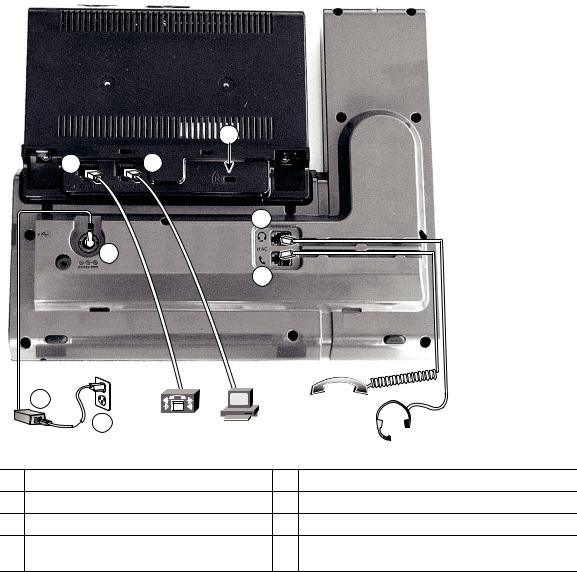
8 |
4 5
Networkrk Computert r
7
1
6
|
2 |
|
276320 |
|
|
|
|
|
3 |
|
|
1 |
DC adapter port (DC48V) |
5 |
Computer port (10/100/1000 PC) |
2 |
AC-to-DC power supply (optional) |
6 |
Handset port |
3 |
AC power wall plug (optional) |
7 |
Analog headset port (headset optional) |
4 |
Network port (10/100/1000 SW) with |
8 |
Anti-theft security lock connector |
|
IEEE 802.3af and 802.3at power enabled |
|
(lock optional) |
2 |
OL-19963-01 |
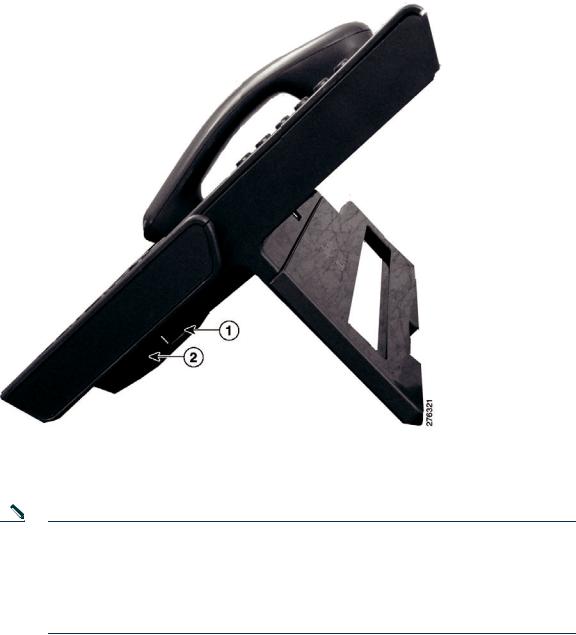
Your Phone
1 |
USB port |
2 |
Cisco Unified IP Color Key Expansion Module connector |
|
|
|
|
Note Each USB port supports a maximum of five supported and nonsupported devices that are connected to the phone. Each device connected to the phone is included in the maximum device count. For example, your phone can support five USB devices (such as three Cisco Unified IP Color Key Expansion modules, one hub, and one other standard USB device) on the side port and five additional standard USB devices on the back port. (Many third-party USB products count as several USB devices.) For more information, see your
system administrator.
Cisco Unified IP Phone 8961, 9951, and 9971 User Guide for Cisco Unified Communications Manager 7.1(3) (SIP) |
3 |
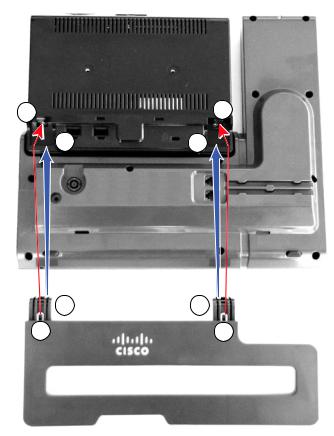
Footstand
If your phone is placed on a table or desk, connect the footstand to the back of the phone.
2 |
2 |
1 |
1 |
1 |
1 |
2 |
2 |
|
|
193118 |
|
|
|
|
|
1 |
Insert the curved connectors into the |
2 |
Lift the footstand until the connectors |
|
lower slots. |
|
snap into the upper slots. |
|
|
|
|
4 |
OL-19963-01 |

Your Phone
Phone Display Viewing Angle
The viewing angle of the phone display can be adjusted according to your preference.
Change Display Viewing Angle
Hold the handset and cradle with your left hand, hold the right side of the bezel (to the right of the display) with your right hand, and then move your hands back and forth in opposite directions to adjust the angle. (The Cisco Unified IP Phone 9971 is shown for illustrative purposes.)
193119
Buttons and Hardware
Your phone provides quick access to your phone lines, features, and call sessions:
•Use the feature buttons (on the left) to view calls on a line or access features such as speed dial or All Calls.
•Use the call session buttons (on the right) to perform tasks such as making a call, answering a call, or resuming a held call. Each call on your phone is associated with a session button.
Cisco Unified IP Phone 8961, 9951, and 9971 User Guide for Cisco Unified Communications Manager 7.1(3) (SIP) |
5 |
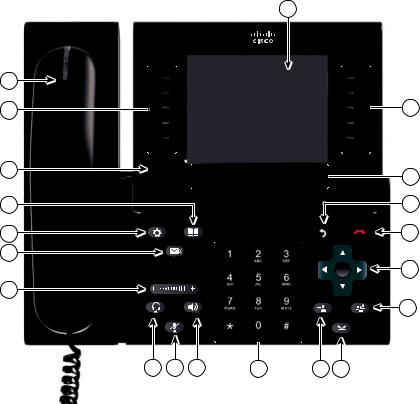
1
20
19
18
17
16
15
14
13 |
12 |
11 |
10 |
9 |
8 |
6
2
3
4
5
6
7
194674
OL-19963-01

Your Phone
1
2
3
4
5
Phone screen |
Shows information about your phone, including directory number, call |
|||||||||||||
|
|
|
information (for example caller ID, icons for an active call or call on |
|||||||||||
|
|
|
hold) and available softkeys. |
|||||||||||
Session buttons |
Each represents a call session and takes the default action for that |
|||||||||||||
|
|
|
session. For example, pressing the session button for a ringing call |
|||||||||||
|
|
|
answers the call, while pressing the session button for a held call |
|||||||||||
|
|
|
||||||||||||
|
|
|
resumes the call. |
|
|
|
|
|||||||
|
|
|
Color LEDs reflect the call state. LEDs can flash (blink on and off |
|||||||||||
|
|
|
rapidly), pulse (alternately dim and brighten), or appear solid (glow |
|||||||||||
|
|
|
without interruption). |
|||||||||||
|
|
|
• |
Flashing amber |
|
|
|
—Ringing call. Pressing this button answers |
||||||
|
|
|
|
|
|
|||||||||
|
|
|
|
the call. |
|
|
|
|
||||||
|
|
|
• |
Solid green |
|
|
|
|
|
—May be a connected call or an outgoing call |
||||
|
|
|
|
|
|
|
||||||||
|
|
|
|
that is not yet connected. If the call is connected, pressing this |
||||||||||
|
|
|
|
button displays the call details or the participants of a conference |
||||||||||
|
|
|
|
call. If the call is not yet connected, pressing this button ends |
||||||||||
|
|
|
|
the call. |
|
|
|
|
||||||
|
|
|
• |
Pulsing green |
|
|
|
—Held call. Pressing this button resumes the |
||||||
|
|
|
|
|
|
|||||||||
|
|
|
|
held call. |
|
|
|
|
||||||
|
|
|
• |
Solid red |
|
|
|
|
—Shared line in-use remotely. Pressing this button |
|||||
|
|
|
|
|||||||||||
|
|
|
|
allows you to barge in on the call (if Barge is enabled). |
||||||||||
|
|
|
• |
Pulsing red |
|
|
|
|
—Shared line call put on hold remotely. Pressing |
|||||
|
|
|
|
|
|
|||||||||
|
|
|
|
this button resumes the held call. |
||||||||||
|
|
|
Icons next to the session buttons indicate an action for that session. For |
|||||||||||
|
|
|
example, pressing the session button with a Missed Calls icon displays |
|||||||||||
|
|
|
your missed calls, and pressing the session button with a Voicemail |
|||||||||||
|
|
|
icon accesses your voice messaging system. |
|||||||||||
|
|
|
(The position of the session buttons can be reversed with the position |
|||||||||||
|
|
|
of the programmable feature buttons on phones that use a locale with |
|||||||||||
|
|
|
a right-to-left reading orientation, such as Hebrew and Arabic.) |
|||||||||||
Softkey buttons |
Allow you to access the softkey options (for the selected call or menu |
|||||||||||||
|
|
|
item) displayed on your phone screen. |
|||||||||||
Back button |
Returns to the previous screen or menu. |
|||||||||||||
Release button |
Ends a connected call or session. |
|||||||||||||
|
|
|
|
|
|
|
|
|
|
|
|
|
|
|
Cisco Unified IP Phone 8961, 9951, and 9971 User Guide for Cisco Unified Communications Manager 7.1(3) (SIP) |
7 |

6 |
Navigation pad and |
The four-way Navigation pad allows you to scroll through menus, |
|
|
Select button |
highlight items, and move within a text input field. |
|
|
|
The Select button (center of the Navigation pad) allows you to select a |
|
|
|
highlighted item. |
|
|
|
The Select button is lit (white) when the phone is in power-save mode. |
|
|
|
|
|
7 |
Conference button |
Creates a conference call. |
|
|
|
|
|
8 |
Hold button |
Places a connected call on hold. |
|
|
|
|
|
9 |
Transfer button |
Transfers a call. |
|
|
|
|
|
10 |
Keypad |
Allows you to dial phone numbers, enter letters, and choose menu |
|
|
|
items (by entering the item number). |
|
|
|
|
|
11 |
Speakerphone button |
Selects the speakerphone as the default audio path and initiates a new |
|
|
|
call, picks up an incoming call, or ends a call. During a call, the button |
|
|
|
is lit green. |
|
|
|
The speakerphone audio path does not change until a new default |
|
|
|
audio path is selected (for example, by picking up the handset). |
|
|
|
If external speakers are connected, the Speakerphone button selects |
|
|
|
them as the default audio path. |
|
|
|
|
|
12 |
Mute button |
Toggles the microphone on or off during a call. When the microphone |
|
|
|
is muted, the button is lit red. |
|
|
|
|
|
13 |
Headset button |
Selects the headset as the default audio path and initiates a new call, |
|
|
|
picks up an incoming call, or ends a call. During a call, the button is |
|
|
|
lit green. |
|
|
|
A headset icon |
in the phone screen header line indicates the |
|
|
headset is the default audio path. This audio path does not change |
|
|
|
until a new default audio path is selected (for example, by picking up |
|
|
|
the handset). |
|
|
|
|
|
14 |
Volume button |
Controls the handset, headset, and speakerphone volume (off-hook) |
|
|
|
and the ringer volume (on-hook). |
|
|
|
Silences the ringer on the phone if an incoming call is ringing. |
|
|
|
|
|
15 |
Messages button |
Auto-dials your voicemail system (varies by system). |
|
|
|
|
|
8 |
OL-19963-01 |

|
|
|
|
Your Phone |
|
|
|
|
|
16 |
Applications button |
Opens/closes the Applications menu. Depending on how your system |
||
|
|
|
|
administrator sets up the phone, use it to access applications such as |
|
|
|
|
call history, preferences, and phone information. |
|
|
|
|
|
17 |
Contacts button |
Opens/closes the Contacts menu. Depending on how your system |
||
|
|
|
|
administrator sets up the phone, use it to access personal directory, |
|
|
|
|
corporate directory, or call history. |
|
|
|
|
|
18 |
Phone display |
Can be positioned to your preferred viewing angle. |
||
|
|
|
|
|
19 |
Programmable feature |
Each corresponds to a phone line, speed dial, and calling feature. |
||
|
buttons |
Pressing a button for a phone line displays the active calls for that line. |
||
|
|
|
|
|
|
|
|
|
If you have multiple lines, you may have an All Calls button that |
|
|
|
|
|
|
|
|
|
|
|
|
|
|
displays a consolidated list of all calls from all lines (oldest at the top). |
|
|
|
|
Then, it is recommended that you keep your phone in the All |
|
|
|
|
Calls view. |
Color LEDs indicate the line state:
•Amber  —Ringing call on this line
—Ringing call on this line
•Green  —Active or held call on this line
—Active or held call on this line
•Red  —Shared line in-use remotely
—Shared line in-use remotely
(The position of the programmable feature buttons can be reversed with the position of the session buttons on phones that use a locale with a right-to-left reading orientation, such as Hebrew and Arabic.)
20 Handset with light strip The handset light strip lights up to indicate a ringing call (flashing red) or a new voice message (steady red).
Cisco Unified IP Phone 8961, 9951, and 9971 User Guide for Cisco Unified Communications Manager 7.1(3) (SIP) |
9 |
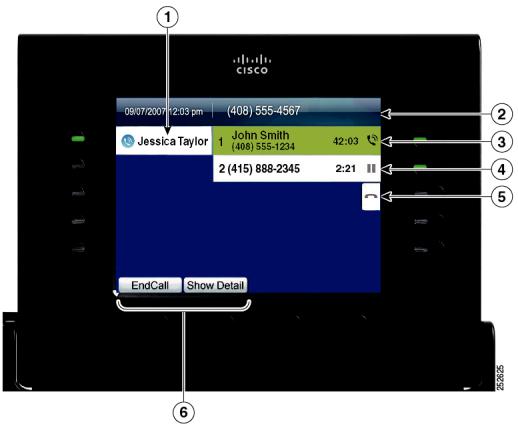
Phone Screen
The way that your system administrator set up your phone determines what is displayed on your phone screen.
Phone with Single Line
1 |
Line label |
Displays the line phone information. |
|
|
|
2 |
Header |
Displays the date and time, and information (such as phone number) about |
|
|
the selected line. |
|
|
(If you are on a call and highlight the header instead of a call, the softkeys |
|
|
that display are the same as those that display when the phone is idle. This |
|
|
is useful, for example, if you want to access the Forward All or New Call |
|
|
softkeys while you are on a call.) |
|
|
|
10 |
|
OL-19963-01 |
|
|
Your Phone |
|
|
|
3 |
Session button label |
Displays information (such as phone number and duration) about a |
|
(for connected call) |
connected call on the line. |
|
|
|
4 |
Session button label |
Displays information (such as phone number and duration) about a held |
|
(for held call) |
call on the line. |
|
|
Pressing the corresponding session button resumes the held call. |
|
|
|
5 |
New Call icon |
Indicates you can press the corresponding session button to make a |
|
|
new call. |
|
|
|
6 |
Softkeys |
Softkey options for the selected (highlighted) call only. |
|
|
If you select a different call (by pressing a feature button or the Navigation |
|
|
pad, or by answering a ringing call), the softkey options may change. |
|
|
|
Phone with Multiple Lines
If you have multiple lines, it is recommended that you use the All Calls button to view all calls on all lines.
If you handle many calls at one time, it is recommended that you use the Answer button to answer the oldest incoming call without having to scroll down the call list and select the call.
For more information, see your system administrator.
Cisco Unified IP Phone 8961, 9951, and 9971 User Guide for Cisco Unified Communications Manager 7.1(3) (SIP) |
11 |

1 |
Primary line label |
Displays information about the primary phone line. |
|
|
Look for the blue icon on the line label to see which line is selected. In |
|
|
this case, the primary line is selected, and the information displayed is |
|
|
for the primary line only. |
|
|
|
2 |
Header |
Displays the date and time, and information (such as phone number) |
|
|
about the selected line. |
|
|
(If you are on a call and highlight the header instead of a call, the |
|
|
softkeys that display are the same as those that display when the phone |
|
|
is idle. This is useful, for example, if you want to access the Forward |
|
|
All or New Call softkeys while you are on a call.) |
|
|
|
3 |
Session label (with |
Displays information (such as call status and duration) about a |
|
Connected Call icon) |
connected call associated with the selected line. |
|
|
|
12 |
|
OL-19963-01 |
|
|
Your Phone |
|
|
|
4 |
Session labels |
Display information (such as call status and duration) about held calls |
|
(with Held Call icons) |
associated with the selected line. |
|
|
Calls are displayed on the right side of the phone screen from the oldest |
|
|
(at the top) to the newest. |
|
|
Pressing the session button next to a Held Call icon resumes the held |
|
|
call for that session. |
|
|
|
5 |
Softkeys |
Softkey options for the selected call only. |
|
|
If you select a different call (by pressing a feature button or the |
|
|
Navigation pad, or by answering a ringing call), the softkey options |
|
|
may change. |
|
|
|
6 |
Answer label |
Displays if your system administrator has assigned the Answer feature |
|
|
to the programmable feature button. |
|
|
Pressing this label or the corresponding button answers the oldest |
|
|
incoming call without having to scroll down the call list and select the |
|
|
call. |
|
|
|
7 |
Speed-dial label |
Displays if you or your system administrator assigned a speed dial to |
|
|
the programmable feature button. This is useful if you tend to have |
|
|
more than five active calls on your phone. |
|
|
|
8 |
Nonprimary line labels |
Display calls and information about nonprimary phone lines. |
|
|
|
9 |
All Calls label |
Displays if the All Calls feature is enabled. Pressing the corresponding |
|
|
button displays all calls on all lines. |
|
|
Calls are displayed on the right side of the phone screen from the oldest |
|
|
(at the top) to the newest. |
|
|
When you are on a call, pressing All Calls once selects the current call |
|
|
or the first call on the list; pressing All Calls twice selects the header. |
|
|
With the header selected, the softkeys that display are the same as those |
|
|
that display when the phone is idle. This is useful, for example, if you |
|
|
have multiple calls on your phone and want to access the |
|
|
New Call softkey. |
|
|
Using the All Calls feature is recommended highly if you have multiple |
|
|
lines on your phone. |
|
|
|
Cisco Unified IP Phone 8961, 9951, and 9971 User Guide for Cisco Unified Communications Manager 7.1(3) (SIP) |
13 |
Phone Screen Navigation and Item Selection
Task |
Action |
Example |
|
|
|
|
|
Scroll to highlight an item. |
Press the Navigation pad. |
Highlight a call from the missed |
|
|
|
call list. |
|
|
|
|
|
Select an item by number. |
Press the corresponding number |
Press 2 to select the second item |
|
|
on the keypad. |
in the Applications menu. |
|
|
|
|
|
Select an item using the |
Press the Select button (at the |
Highlight the Preferences |
|
Select button. |
center of the Navigation pad). |
application and press the |
|
|
|
Select button. |
|
|
|
|
|
Navigate to a submenu. |
Highlight the menu item and |
Highlight the Network Setup |
|
(A right arrow (>) next to the |
press the item number on |
menu, then press 1 to open |
|
the keypad. |
the submenu. |
||
menu item indicates that a |
|||
|
|
||
submenu exists.) |
Or press the down arrow on the |
|
|
|
Navigation pad and then press |
|
|
|
the Select button. |
|
|
|
|
|
|
Select a line to use a calling |
Press the line button. |
Press the line button and then |
|
feature (when the line is idle). |
Indicators of your line |
press the Forward All softkey to |
|
|
forward calls on that line. |
||
|
selection include: |
||
|
|
||
|
• The selected line is |
|
|
|
displayed on the phone |
|
|
|
screen header. |
|
|
|
• Color of the icon (on the |
|
|
|
line label) changes to blue. |
|
|
|
|
|
|
Select a line to use a calling |
Press the line button twice. |
Press the line button twice and |
|
feature (when the line has one or |
Indicators of your line |
then press the Forward All |
|
more active calls). |
selection include: |
softkey to forward calls on |
|
|
that line. |
||
|
• The selected line is |
||
|
|
||
|
displayed on the phone |
|
|
|
screen header. |
|
|
|
• Color of the icon (on the |
|
|
|
line label) changes to blue. |
|
|
|
|
|
14 |
OL-19963-01 |
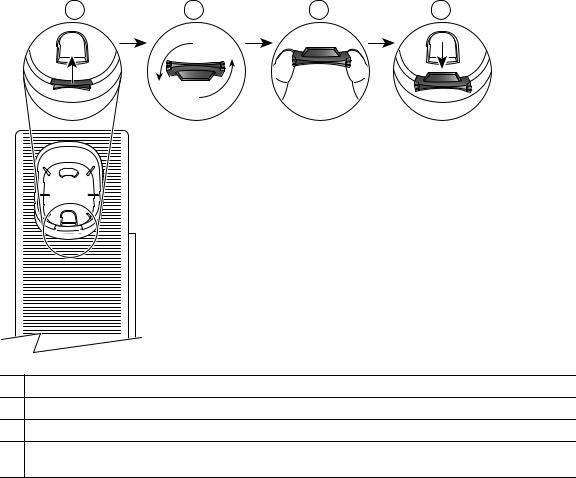
Your Phone
Power-Save Mode
Depending on how your system administrator set up your phone, the phone display may go into a power-save mode (the phone screen appears blank and the Select button is lit white).
To turn on the phone display, press any button or pick up the handset.
Handset Rest
Your system administrator may have mounted your phone on a wall. With a wall-mounted phone, you may need to adjust the handset rest to ensure that the receiver does not slip out of the cradle.
1 |
2 |
3 |
4 |
275943
1Remove the handset from the cradle and pull the plastic tab from the handset rest.
2Rotate the tab 180 degrees.
3Hold the tab between two fingers, with the corner notches facing you.
4Line up the tab with the slot in the cradle and press the tab evenly into the slot. An extension protrudes from the top of the rotated tab. Return the handset to the handset rest.
Cisco Unified IP Phone 8961, 9951, and 9971 User Guide for Cisco Unified Communications Manager 7.1(3) (SIP) |
15 |
Cisco Unified IP Phone 9951
The Cisco Unified IP Phone 9951 provides these features:
•Phone connections
•Bluetooth
•Footstand
•Phone-display viewing angle
•Buttons and hardware
•Phone screen
•Power-save mode
•Handset rest
Phone Connections
Your system administrator can help you connect your phone to the corporate IP telephony network.
16 |
OL-19963-01 |
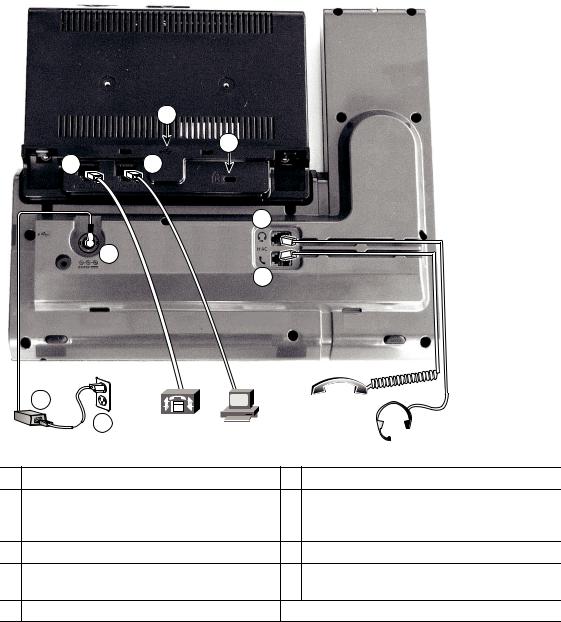
Your Phone
8 |
9 |
4 |
5 |
Networkrk |
Computert r |
7
1
6
|
2 |
|
193117 |
|
|
|
|
|
3 |
|
|
1 |
DC adapter port (DC48V) |
6 |
Handset port |
2 |
AC-to-DC power supply (optional for the |
7 |
Analog headset port (headset optional) |
|
network port connection but required for a |
|
|
|
wifi connection) |
|
|
3 |
AC power wall plug (optional) |
8 |
USB port |
4 |
Network port (10/100/1000 SW) with |
9 |
Anti-theft security connector (lock optional) |
|
IEEE 802.3af and 802.3at power enabled |
|
|
5 |
Computer port (10/100/1000 PC) |
|
|
Cisco Unified IP Phone 8961, 9951, and 9971 User Guide for Cisco Unified Communications Manager 7.1(3) (SIP) |
17 |
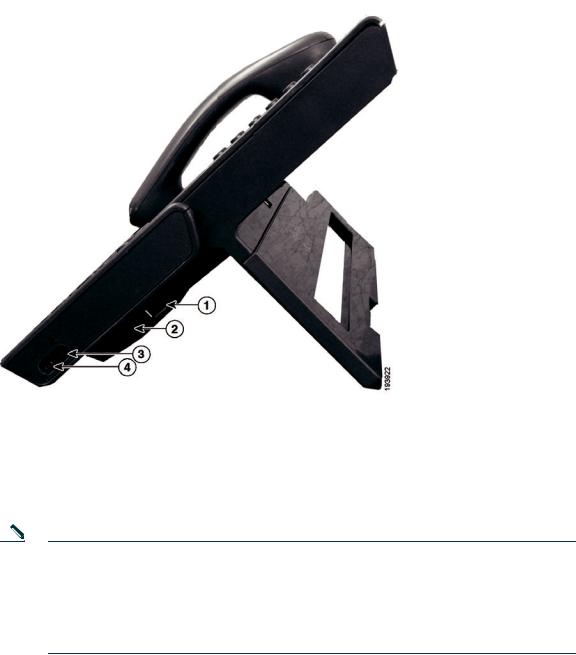
1 |
USB port |
3 |
Speaker port for output to optional |
|
|
|
external speakers |
|
|
|
|
2 |
Cisco Unified IP Phone Expansion |
4 |
Microphone port for input from |
|
Module 7917 connector |
|
optional external microphone |
|
|
|
|
Note Each USB port supports a maximum of five supported and nonsupported devices that are connected to the phone. Each device connected to the phone is included in the maximum device count. For example, your phone can support five USB devices (such as three Cisco Unified IP Color Key Expansion modules, one hub, and one other standard USB device) on the side port and five additional standard USB devices on the back port. (Many third-party USB products count as several USB devices.) For more information, see your
system administrator.
18 |
OL-19963-01 |
Your Phone
Bluetooth
Your phone supports Bluetooth Class 2 technology when the headsets support Bluetooth. You can add and connect up to five Bluetooth headsets to your phone, but the last Bluetooth headset connected becomes the default for use with the phone.
Related Topics
Bluetooth Headsets, page 111
Cisco Unified IP Phone 8961, 9951, and 9971 User Guide for Cisco Unified Communications Manager 7.1(3) (SIP) |
19 |

Footstand
If your phone is placed on a table or desk, connect the footstand to the back of the phone.
2 |
2 |
1 |
1 |
1 |
1 |
2 |
2 |
|
|
|
193118 |
|
|
|
|
1 |
Insert the curved connectors into the |
2 |
Lift the footstand until the connectors |
|
lower slots. |
|
snap into the upper slots. |
|
|
|
|
20 |
OL-19963-01 |
